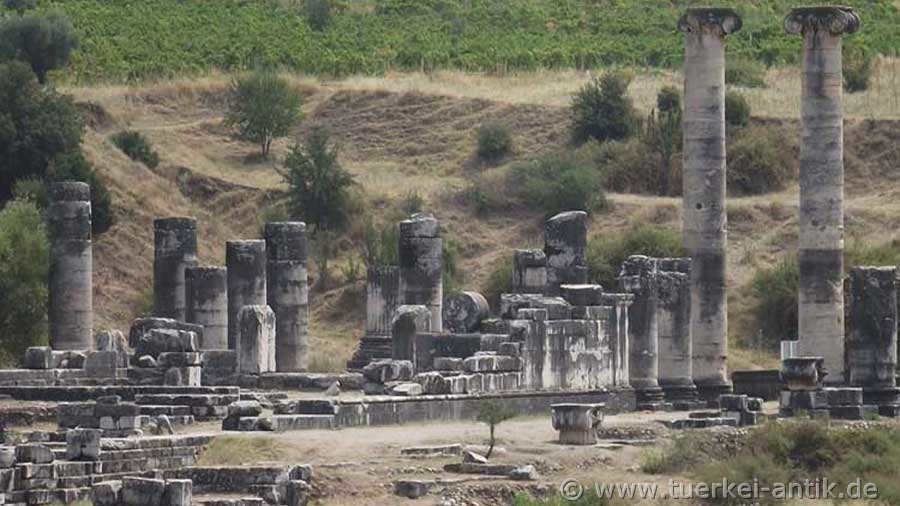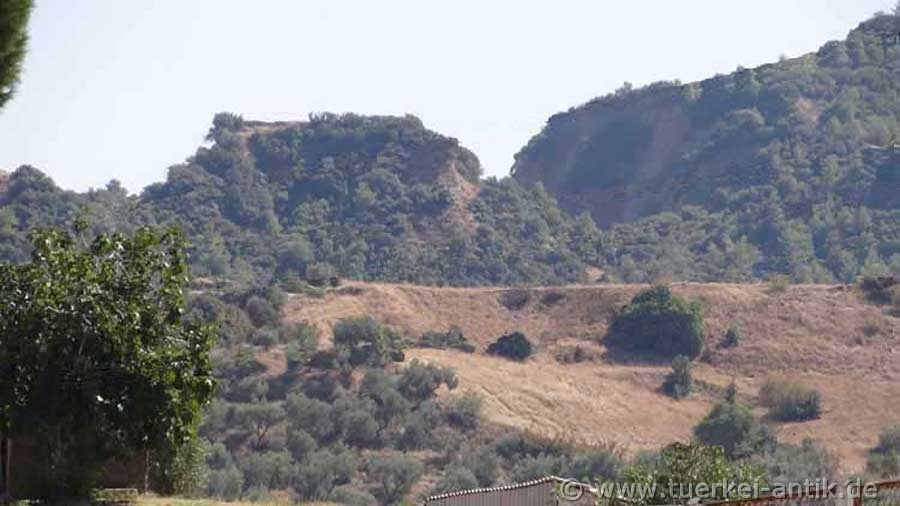 |
| Sardis in Lydia | |||
|
|
|
||
| The Gymnasium | |||
|
Sardes was the capital of the ancient kingdom of Lydia, later the seat of a judicial district in the Roman province of Asia, capital of the province of Lydia in Late Antique and Byzantine times. The remains of the city lie about ten kilometres west of the present city of Salihli. |
|||
|
|
|||
| The Palestra before the Gymnasium | |||
|
The former Kingdom of Lydia was highly developed in crafts and trades and Sardes was considered to be the headquarters of production, centred on the production and dyeing of sensitive wool and carpets. In Hittite times the city was probably called Uda, among the heraclids Hyde. |
|||
|
Sardes also became the starting point for the 2,500 km long Persian royal road to Persepolis. In 499 BC Sardes and its temples were destroyed by the Greeks during the Ionic Uprising, which was avenged by them in the subsequent Persian Wars.
|
|||
|
|
|||
| In the Synagogue | |||
|
|
|||
| The altar of the Synagogue | |||
|
|
|||
|
Among the Seleucids, Jewish war veterans were settled in Sardes, which later encouraged the emergence of an early Christian community.133 BC saw Sardes become part of the Roman province of Asia and the capital of a judicial district.
|
|||
|
|
|||
 |
|||
| The Gymnasium | |||
|
|
|||
|
When Constantinople became the capital of the Byzantine Empire, a new road system developed that connected the provinces with the capital. Thus Sardes increasingly came to the edge and lost its meaning. However, the city retained its formal sovereignty and remained the bishopric of the province of Lydia from 295. After Ephesus and Smyrna, the city took the third place of Thracian cities under Constantine VII's Porphyrogennetos in the 10th century, but over the following four centuries it came under the shadow of the provinces of Magnesia ad Sipylum and Philadelphia, which consolidated its role in the region. |
|||
|
|
|||
|
|
|||
|
Remains of residential and commercial buildings |
|||
|
Until the 19th century Sardes was desolate and mainly buildings of Roman times were visible. Since 1958, Harvard University and Cornell University have supported annual archaeological expeditions to Sardes. The ruins of today's city give an idea of its old splendour through its partial restoration. The reconstructed gymnasion from the 3rd century is worth seeing north of today's main street, next to it the synagogue, richly decorated with floor mosaics and inlays on the walls, probably from the same period. On its long side are remains of residential and commercial buildings. |
|||
 |
|||
| The Temple of Artemis | |||
|
On the southern side of the road in Greek Sardes stands the temple of Artemis, built from the 4th to 2nd century B.C., which should have reached the temples of Ephesus and Didyma in its planned dimensions, but was never completed. |
|||
 |
|||
| The Trough of the Theatre | |||
|
AIn the slope diagonally opposite the gymnasium and the synagogue was the Greek-Roman theatre, of which only a few remains are visible today. Directly in front of the theatre was the stadium of the city. Also from this only the hollow is visible today. |
|||
| Photos: @chim, Monika P. | |||
| Translation aid: www.DeepL.com/Translator | |||
| Source: Wikipedia and others | |||
|
|
|||

